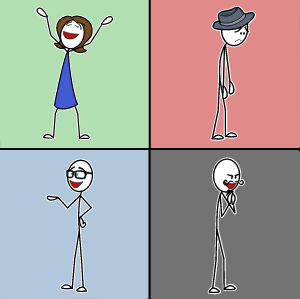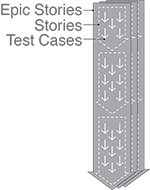Quick Review of Agile User Stories

Agile user stories are a great solution to this problem. Always popular in software engineering, I’m increasingly seeing companies use them for projects in other areas, like marketing. That said, agile stories are not a silver bullet. They encourage good storytelling but don’t guarantee it. Supplementing your major storyboards will help you avoid arbitrary stories, disconnected from (even hypothetical) customer realities.
First off, agile user stories have this format:
I want to [do something]
so that I can [derive a benefit]”
Second, to help stay organized and coherent, stories are often nested within ‘epic stories’. If you’re new to product development, you’ll probably find yourself writing stories that turn out to be epic stories as you get into their particulars. Finally, ‘test cases’ are a good way to layer additional detail against your stories. (see agile user story examples for more).

Storyboards are a great way to humanize and describe epic stories:

Creating an Epic User Story
Let’s take a look at an example epic. I use a (fictional) company called Enable Quiz in my book. They offer lightweight technical quizzes. Managers use the quizzes to screen new candidates and also assess the skill sets of their existing teams so they can plan training, etc. Let’s say the persona ‘Frank the Functional Manager’ wants to assess one of his teams so he can plan a skills development program. The ‘epic user story’ might be:I want to administer a skills audit
so that I can understand the capabilities of my staff and plan training.’
The storyboard below summarizes a few agile user stories that sit within that epic story:

Extracting User Stories out of An Epic
The story above an epic story, meaning it had multiple sub-stories within it to flesh out the details. You may find a table helpful for unpacking the detail you’re narrating with your epic storyboard. Here’s an example for the epic story above. This epic assumes Frank and his company have already successfully on-boarded with Enable Quiz, using it for screening new recruits.| Notes | Board |
|---|---|
|
This epic assumes Frank and his company have already successfully on-boarded with Enable Quiz, using it for screening new recruits. Frank’s first goal is to set up a quiz to complete a skills audit for his team. He has the employees he wants and it’s part of his job to help them make time to develop a holistic skill set. This first step covers these two stories:
A) “As a functional manager, I want to browse the quiz banks [of available questions] so I can make sure I’m subscribed to all the necessary topics for my skills audit.” B) “As a manager, I want to purchase additional quiz banks so I can add additional technical topics to me quizzes.” |
 |
|
Frank has some topics specific to their internal products, processes and technologies that he’d like to use for his internal staff. After that, he’s ready to send the quiz. This panels deals with the following two stories:
C) “As a manager, I want to create a custom quiz banks so I can add my own questions to the quiz.” D) “As a manager, I want to create a quiz so I can use it with my staff.” |
 |
|
Now Frank has to get all his staff into the systems so they can get invitations and their individual results tracked. He might want to do this in bulk and/or on a one by one basis.
E) “As a manager, I want to create a list of students [employees] from an Excel file so I can invite them to take the quiz.” F) “As a manager I want to create a list of students [employees] online.” G) “As a manager, I want to invite a set of students [employees] to take the quiz so I can see their scores.” |
 |
|
Now the employees/students come into play. They need to get a notice that Frank can customize where he communicates what this is about and when he’d like to have them finish the quiz. Suggestions show him how to communicate that the purpose of the quiz is creation of tailored professional development/training vs. micromanagement/big brothering.
H) “As a student, I’d like to understand the objectives and content of the quiz as well as when I need to do it by so I can understand and prioritize it.” |
< |
|
People get busy, etc. Frank needs to see who’s finished vs. not so he can send automated and/or human reminders to finish up the quiz.
I) “As a manager, I want to see which students have completed the quiz and which have not so I can send them a reminder.” |
 |
|
Now he has his result. The objective was to tailor training programs for his team so they’re able to broaden their skill sets in the context of their business schedule.
J) “As a manager, I want to see how the students scored on the test so I can put in place a skills improvement program.” |
 |
Why user stories? Storyboards?
Here are a few more reasons I like the user of stories:- They dovetail with design thinking outputs like personas, problem scenarios and value propositions.
- They are highly consumable by developers, designers, and other creators who are helping you execute, balancing structure and description; specificity and objectives.
- They’re robust and ‘nestable’, scalable even for large, complicated projects.
Storyboards are a great way to keep agile user stories from mimicking the dull, context-free requirements definitions they were meant to replace. They help avoid myopia, making sure you’ve thought through the whole story. They’re also a great way to engage your audience.
If you’d like more on storyboarding, I have a post here on using them for Customer Discovery/Development and another on using them for thinking about User Acquisition & Lifecycle.
Your Turn
What have you tried to improve the quality of your agile user stories? What worked? Didn’t? Have you tried storyboards? Would you? Post a comment, respond on Twitter, drop me a line, post on LinkedIn - we're in this together!About Alexander Cowan
By Alexander Cowan - Reposted with permission from AlexanderCowan.comAlex Cowan is the founder and CTO of Leonid Systems, a software company providing solutions to the world's largest communications providers. He has worked with companies ranging from start-ups to Fortune 100s, improving their competitive advantage in a fast-changing high-tech landscape. He lives in Aptos, California, and can be reached at www.alexandercowan.com, on Google Plus at Alexander Cowan.
How Tos about Exit Flatsville – How to Use Storyboards to Energize Your Agile User Stories
How to introduce agile user stories to your students using real-world classroom scenarios
Use relatable situations from your classroom to help students understand agile user stories. Pick a classroom activity or challenge (like organizing a group project) and model a user story together. This makes the concept relevant and easy to grasp for young learners.
Guide students to brainstorm their own personas for classroom projects
Encourage students to invent classroom personas (e.g., 'team leader', 'researcher', 'presenter') for group activities. Ask them to describe what each persona wants and why. This helps students practice empathy and clear communication.
Model writing a simple agile user story as a class
Write a user story together using the agile format: 'As a [persona], I want to [do something] so I can [benefit].' Show students how to fill in each part based on your classroom scenario. Visual modeling demystifies the process and builds confidence.
Help students refine their user stories for clarity and specificity
Ask students to review their stories and add details to make each step clear. Discuss how each story can help solve a classroom challenge or improve a project. Specificity leads to better results and deeper understanding.
Use group feedback to improve and test classroom user stories
Have students share their stories with peers, gather suggestions, and revise for clarity. Peer feedback encourages collaboration and gives students real practice with agile thinking.
Frequently Asked Questions about Exit Flatsville – How to Use Storyboards to Energize Your Agile User Stories
What is an agile user story and why is it important?
Agile user stories are short, structured descriptions of a feature from the user's perspective, typically formatted as "As a [persona], I want to [do something] so that I can [derive a benefit]." They help teams focus on customer experience and make ideas testable, improving collaboration and project outcomes.
How can educators use agile user stories in their lesson planning?
Educators can apply agile user stories to lesson planning by defining goals from the student's perspective, breaking lessons into manageable steps, and ensuring every activity has a clear purpose and benefit. This approach encourages reflection and improves student engagement.
What’s the best way to write an effective agile user story?
The best way is to follow the format: As a [persona], I want to [do something], so that I can [derive a benefit]. Make stories explicit, focused on real needs, and testable. Supplement stories with storyboards and test cases for added clarity.
What is the difference between an epic story and a user story in agile?
An epic story is a large, high-level user story that encompasses multiple related tasks or features. Individual user stories break down the epic into detailed, actionable items, making project management easier and more organized.
What are some examples of agile user stories for classroom or training settings?
Examples include: As a teacher, I want to create custom quizzes so I can assess my students’ skills, or As a student, I want to understand the objectives of the lesson so I can prioritize my study. These stories clarify intent and desired outcomes for all participants.
© 2025 - Clever Prototypes, LLC - All rights reserved.
StoryboardThat is a trademark of Clever Prototypes, LLC, and Registered in U.S. Patent and Trademark Office
